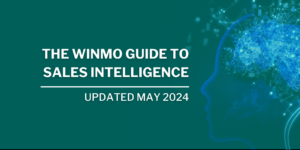
The Winmo Guide to Sales Intelligence: Updated May 2024
The most successful salespeople research, monitor, and analyze their prospects’ pain points. Yet, gathering this information can take time, especially as B2B purchasing decisions are made by a committee of multiple stakeholders rather than a single individual. To move a buying decision forward, new business professionals need insights to understand the needs of the decision-makers who make up that committee. This is where sales intelligence tools like Winmo come in.
Sales intelligence tools are, first and foremost, a timesaver, enabling you to measure, track, and analyze crucial data points, helping you develop strategic sales processes to reach the right people at the right time. Let the platform handle the grunt work and focus on what you do best — selling.
Keep reading to discover four ways sales intelligence tools like Winmo help sales professionals close deals by providing actionable insights and data on prospects, enabling more targeted and effective sales strategies.
1) By successfully navigating buying committees
In today’s complex B2B sales environment, purchasing decisions are rarely made by a single individual. Instead, they involve a buying committee comprising multiple stakeholders, each with their own perspectives, priorities, and influence on the final decision. Good sales intelligence connects the dots between individuals within an organization and the organization itself, marrying firmographic data with unique insights on buying committees to help sellers navigate these complexities effectively.
Navigating the hierarchy of a potential client can be daunting without the right information. Winmo helps you identify the key influencers and decision-makers within a company so you can:
- Map out the decision-making process: Understand the structure and workflow of the buying committee. This knowledge helps craft messages that resonate with each stakeholder’s specific interests and responsibilities.
- Target the right individuals: Focus on individuals with the most significant influence over the purchasing decision, increasing the likelihood of moving the deal forward.
- Build stronger relationships: Establish connections with multiple stakeholders within the committee to build a coalition of supporters for your solution.
2) By striking while the iron’s hot
In the fast-paced world of B2B sales, having a wealth of data at your fingertips is only beneficial if you know how to use it effectively. Timing is a crucial factor in sales success, and knowing when to reach out to prospects can significantly impact the outcome of your efforts. Sales intelligence tools provide critical insights that help sales professionals identify when to engage with potential clients, ensuring that their outreach is both timely and relevant.
Winmo customers often tell us that determining the right time to reach out is half the battle. By leveraging various timing triggers, sales professionals can make informed decisions about when to initiate contact, follow up, or present a proposal. These triggers include:
- Planning and buying periods: Knowing when a company plans its annual media campaigns or budget allocations can provide a perfect opportunity to pitch your solution. Winmo tracks these periods, helping you align your outreach with times when companies have the funds and the need for new tools, services, or partnerships.
- New decision-maker hires: New hires, especially in key decision-making roles, often bring fresh perspectives and are open to new ideas and solutions. They might also be in the process of onboarding new agencies, tools, and technologies. Winmo alerts you to these changes, enabling you to introduce your product or service at a time when the new decision-maker is most receptive.
- Funding rounds: Companies that have recently secured funding are often in a growth phase and are looking to invest in marketing, technology, and other areas to scale their operations. Winmo tracks funding rounds, giving you the insight to approach these companies when they are actively seeking new solutions and have the financial resources to make a purchase.
Not all timing triggers are created equal, and understanding which insights to focus on and when can make a significant difference. Winmo helps you prioritize your outreach efforts based on the most relevant and impactful timing triggers.
3) By boosting your pipeline
Of course, you need to know more than just what these tools do. Here are three practical tactics you can implement to generate leads with sales intelligence.
Target: Segment by the types of companies you want to sell to and then build profiles around the individual decision-makers:
- Build targeted lists of highly qualified advertiser and agency contacts
- Filter prospect lists by criteria like title, territory, industry, and revenue
- Zero in on individual contacts, as well as agency partners they work with
- Find leads’ contact information (no more scouring LinkedIn!)
- Connect the dots between decision-makers and other key stakeholders
- Discover new leads with qualities similar to your customers
Predict: Predictive analytics tools provide insight into buying patterns, as well as industry and organizational trends so you can reach out at the right time.
- Analyze and provide insight into buying patterns
- Track online behaviors, content consumed, and other buying signals
- Make accurate predictions about who will be ready to buy — and when
- Track events, industry, and vertical news and receive sales predictions
- Track changes and triggers like new funding, product launches, and decision-maker turnover to find sales opportunities
Optimize: Streamline their sales processes, enhance decision-making, and ultimately drive higher revenue by efficiently targeting the right prospects.
- Integrate the many tools (email, CRM, social media…) that you use to market and communicate with prospects in one place
- Get reminders to follow up with leads so they don’t slip through the cracks
- Quickly generate emails or call scripts and plug-in contact information for you
- Get alerts and recommendations for new leads and opportunities
4) By empowering your team to focus on selling (not prospecting)
Choosing an easy-to-use sales intelligence tool like Winmo — with fresh, relevant, human-verified data — can significantly enhance your prospecting efforts, saving you time and ensuring you connect with the right decision-makers. By leveraging advanced technologies, understanding company structures, and networking effectively, you can optimize your sales processes and achieve your business goals. Request a Winmo trial today to experience these benefits firsthand.






